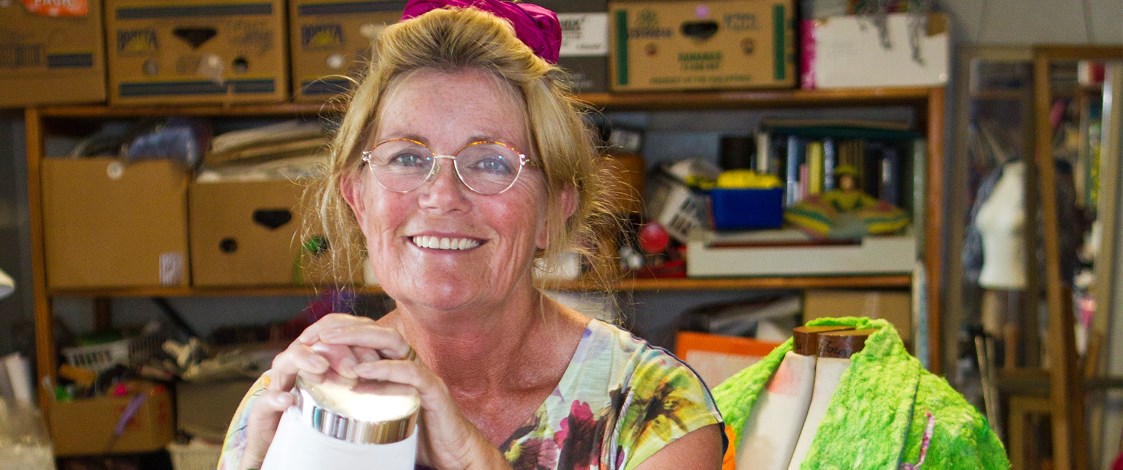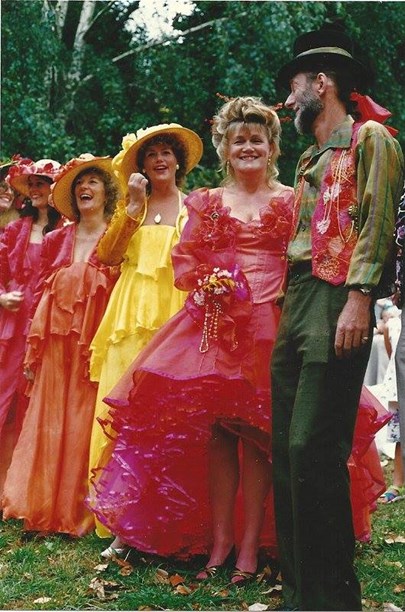Stories
Yanny Split
11 Dec 1947 - 4 Dec 2022

At the beginning of 2013 Yanny Split enjoyed an artistic triumph. The Wonderful World of Yanny Split, saw seven of the 26 garments she donated to the museum on display. The balance was worn in a fashion parade as part of the exhibition's opening, a preview of infinite colour. Yanny always preferred her art to be seen on the human body.
Yanny's involvement in New Zealand fashion design and wearable art stretched back to 1987. While countless shows, fashion parades and award wins marked her creative path, an exhibition dedicated exclusively to her work at Waikato Museum was a definitive career high point. Leafa Wilson, Waikato Museum's then concept leader in visual arts, declared Yanny a "Waikato treasure" and a "unique designer and textile artist". Doris de Pont, her friend and former business partner, says Yanny was "always bold", possessing "the courage to just do what was needed" to realise her ambition. Modest beginnings, linguistic eccentricity and the improbable domicile of Huntly proved no impediment.
Pictured are some of the 26 items she donated to the Waikato Museum and images from the fashion parade at the opening of the exhibition.
Jannie Groeneweg was born 11 December 1947 in Bovenkerkerpolder, North Holland, the second of the 12 children of Aart and Antje Groeneweg. It was a traditional orthodox Protestant family, challenged by the deprivations of post-war life, squeezed into what Yanny's sibling Anita describes as a "far too tiny house". By necessity, the sisters slept together in a bed in the attic. When Yanny was ten the family moved to Amstelveen, near the Amsterdamse bos (wood). Again, the accommodation struggled to contain 14 people. It was here that Yanny's first textile artwork, a felt cut-out stitched on fringed jute, was created at age 10, at a church craft workshop.
After completing her primary education, Yanny was asked to choose between attending regular secondary school and a "ladies school", known colloquially as the "spinach academy", where instruction was given in cooking, pattern making and sewing. She chose the latter. Less suited to her burgeoning talents were typing lessons, where Yanny established that a career in secretarial work was not for her.

Yanny Split’s first artwork was made as a 10-year old in Holland. Image credit: © Stuff.
Leaving school at 14, she began cleaning houses. At 15, Yanny was working in a bakery, where she learned pastry making. She continued her education at night school. Classes in window dressing and commerce led to employment in retail assistance and shop management. In 1968, she secured a position as a window dresser for Vroom en Dreesman, a large department store, and would continue in that capacity for C & A, a fashion department store. After a stint managing a cafe and bar, further night schooling in floristry saw her open her own business in 1976 in south Amsterdam, selling flowers and plants and maintaining the plants in the surrounding businesses and institutions.
Yanny's first marriage necessitated that she sell the floristry business and take a job managing a sporting complex. Her divorce provided focus and impetus. In 1981, aged 35, she enrolled in Vrije Academie, an art school, discovering her métier. A year's study in The Hague was followed by four years in Rotterdam, where the renowned designer Cargelli proved a supportive mentor, beginning a personal and professional friendship that would be sustained in the decades to come.
The course in fashion design was comprehensive, covering preliminary design, pattern drawing and cutting, silk painting, applique, knitting, millenary and the organisation of fashion parades. There were trips to Paris and holidays in the South of France.
In 1985, together with five other students of the Vrije Academie, Yanny established a fashion cooperative in The Hague, Studio Split, as an outlet for their respective work. It was here that she met visiting New Zealand fashion designer Doris de Pont. Although the business was formally a co-operative, Yanny, says de Pont, "was the driver - organising promotions like 'a day at the races' - where we all dressed up in our finest and paraded around as a group - determined to draw attention...[with] flyers on hand to direct our new customers". Fashion shows at the beach pavilions in Scheveningen and a group show featuring 120 outfits, at Artline, a dealer gallery in The Hague, were further Yanny initiatives, carried out on a grand scale.
A photo of the Studio Split team, a promotional day on the Boulevard at Scheveningen. Second image, The Artline Show from 1985, Image credit: © Stuff.
Studio Split was the star that shone twice as bright, lasting but a year. Yanny's work failed to sell as well as that of her partners. "My ones were just a little far out" she told the Waikato Times' Denise Irvine in 2013. It was clear to her that she would not survive as a dressmaker.
Making good on a promise that if she were not happily settled in her country of birth before she was forty, she would emigrate, in 1987 Yanny shifted to New Zealand. With the relocation came the formalising of her professional moniker. Reasoning that Jannie Groeneweg was too difficult for New Zealanders to correctly pronounce - and lacked the impact she desired - Yanny changed the spelling of her first name and appropriated Split from her studio to serve as a second name.
Yanny Split outside the shop in O’Connell St, Auckland 1987, and inside fitting an outfit on model Michaela.
Initially joining Doris de Pont in her fashion store in Auckland's O'Connell St, Yanny again came to the conclusion that "the commercial side of the clothing business did not appeal". More interested in "making a statement through design" she combined a part-time job in the sample room of Candy Textiles with designing, entering awards shows and "experimenting with new ideas". Subsequently, employment with Singer, selling and demonstrating sewing and knitting machines, continued to subsidise Yanny's art, as did part-time employment in sundry Auckland restaurants.
Yanny made an immediate impression at the Benson & Hedges Fashion Design Awards, her creations nominated in 1988, 1989 (twice) and 1990 (three times). In 1990 she won the Wool Section, for, as de Pont describes, "an outfit with a pagoda silhouette; wide pants, an A-line tunic and a cropped jacket - all in white wool". There was considerable irony in the fact that "not a hint of colour or embellishment" was apparent.
Winner of the Benson and Hedges ‘Fashion in Wool Award’ 1990.
Throughout the 1990s and beyond Yanny's work continued to appear at the Benson & Hedges awards - subsequently rebranded the New Zealand Smokefree Fashion Awards - with 13 nominations in total. From 1991 until 2005, she also turned her attention to the World of Wearable Arts competition with a remarkable 33 entries accepted, inclusive of six garments in 1995 alone. In 1993 she won the Wool Section with a multicoloured machine-knitted outfit inspired by reggae icon Bob Marley.
Winner World of Wearable Art Wool Section 1993 modelled by Anja van Polanen Petel and at the WOW Awards night.
Yanny's successes in awards and exhibitions throughout the country are too numerous to list. Aside from prestigious exposure in art galleries as far afield as New Plymouth, Christchurch and around Auckland, her fashion parades graced museums, nightclubs, race meetings and once - infamously - a nudist club. A parade in downtown Auckland for the royal visit of Queen Beatrix of the Netherlands in 1992 was a particularly memorable tribute to her home country.
Yanny met Alan Coates, an antiques dealer, at an Auckland nightclub. The pair's instant rapport withstood the inconvenience of Alan's imminent departure overseas, with Yanny, after the briefest of hesitations, electing to pick him up from the airport. Their 1994 wedding, in Auckland, not far from their residence, a warehouse large enough to accommodate both their professional pursuits, was an extravaganza of colour.

The 1994 wedding of Yanny Split and Alan Coates was described as an extravaganza of colour.
To the surprise of many, Yanny and Alan elected to settle in Huntly, downsizing considerably but keeping up her creative practice and entering competitions often working with locally sourced materials. In 2006, Stitch, a book about New Zealand contemporary textile artists, devoted a chapter to Yanny's work.
Spirograph, WOW, Fashion Waves section, 1999, Milky Way, Trash to Fashion 1998, made from milk vat liners.
Having taught fashion design part-time as a tutor at Unitec, Yanny continued as an educator in the Waikato, teaching summer classes at the Raglan Art School and at Huntly College, eventually becoming the adult community education coordinator for the latter. She took workshops all over the region and established an arts trail and arts events in Huntly. Yanny served as a trustee and deputy chairwoman of the Arts Development Trust, Arts Waikato. In 2010 she received Arts Waikato's Outstanding Service Award.
Flyer for Summer School, Huntly College student workshop, Celebration of Colour dyeing workshop.
Never quite mastering the English tongue, Yanny was supported in her written expressions, as she was in all her endeavours, by Alan, a more than useful editor. Whilst what Doris de Pont calls her "Yannyisms" often amused friends and acquaintances alike, she never allowed her imperfect command of the language to limit her. "Despite her quirky turn of phrase", says de Point, "her idiosyncratic spelling and pronunciation - you always understood what she meant".
In the words of one of her sisters, Yanny was a "passionate maverick, creative, energetic, quirky [and] impetuous". In her life, as in her art, there was "always movement".
Yanny Split died on 4 December, 2022. She is survived by her husband Alan Coates, a large extended family in the Netherlands and an extensive catalogue of creative making.
Text by Richard Swainson.
First published in the Waikato Times, 24 December 2022.
Published November 2023.
Banner image: Yanny in her Huntly Studio, 2013 image courtesy of Stuff Ltd.